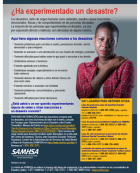This brochure features the national Disaster Distress Helpline, which supports people who are coping with the after effects of a disaster. Learn about a disasters’ potential to cause psychological stress, warning signs of distress, and tips for coping.
Dashboard: Filter Bricks
Main page content


Disaster survivors are not always aware of behaviors in themselves or others that are associated with adverse reactions to a disaster. This poster assists adult disaster survivors with identifying possible reactions and provides resources to turn to for help.
Los sobrevivientes de acontecimientos catastróficos no siempre están conscientes de los comportamientos, sea en sí mismos o en otras personas, que están relacionados con reacciones adversas a estas experiencias. Este póster ayuda a los adultos que han sobrevivido un acontecimiento catastrófico a ide.

This tip sheet contains information about grief, the grieving process, and what happens when the process is interrupted and complicated or traumatic grief occurs. It also offers tips and resources for coping with both types of grief.

This fact sheet provides Health Care Practitioners and Disaster Responders with guidelines for communicating with survivors experiencing grief. It give background information about the grieving process and what happens when the grief process is interrupted and complicated or traumatic grief occurs is included as well as helpful resources for additional assistance.

This brochure explains the signs and symptoms of retraumatization. Gives guidance on how to manage the symptoms. It provides resources for building resilience and an adequate support system for dealing with triggering events.

Cómo hacer frente a una emergencia en la que es necesario refugiarse en sitio
Esta hoja de consejos contesta algunas preguntas frecuentes sobre cómo hacer frente a una emergencia que requiera que usted se refugie en el sitio donde se encuentre. Ofrece consejos para lidiar con la situación; explica las reacciones comunes a tener que refugiarse en sitio; da consejos sobre cómo cuidar su salud mental y la de su familia; y proporciona recursos útiles adicionales.

This fact sheet provides tips for coping with sheltering in place. It explains common reactions when sheltering in place, and provides recommendations for caring for oneself and the family.

This fact sheet discusses tips on how to cope with grief after an incident of community violence. It introduces common signs of grief and anger, and offers tips for helping children deal with grief.

This fact sheet offers tips to help disaster response workers transition back to routine work. It provides information on managing stress, and how to overcome other difficulties, such as fatigue and a lack of control over emotions.
Displaying 1 - 10 out of 30


